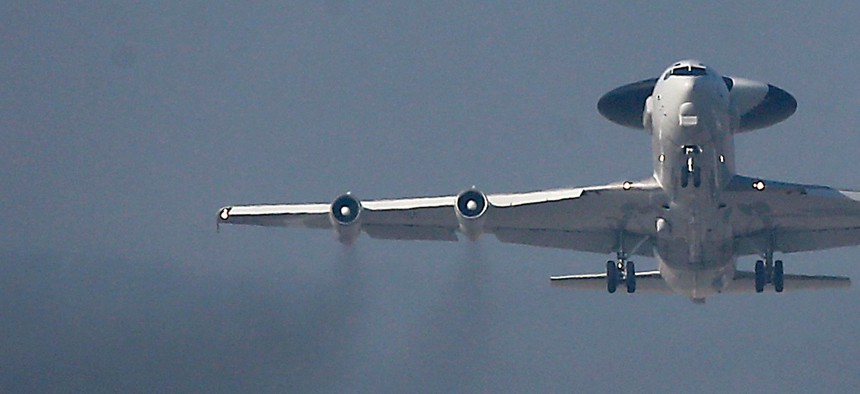
A NATO AWACS plane takes off the NATO Airbase in Geilenkirchen, Germany on March 12, 2014. Russia's readiness to use military force in Ukraine has been a wake-up call for many European countries. Frank Augstein/AP
Bringing NATO Into the 21st Century
NATO has to acknowledge that the world has changed since 1949 and it's time to act differently. By Marc Jacobson
Earlier this month, the Department of Defense released its update to the 2006 Army and Marine Corps Counterinsurgency Field Manual—an update that sought to take what has been learned since the “surges” and “transitions” in Afghanistan and Iraq. The release of this manual should serve as a reminder not just to those in Washington, DC, but to our NATO allies across the Atlantic that however much one might wish that defending national interests will not require engaging in difficult and messy contingencies such as Afghanistan, history tells us we may likely have to do just that.
NATO has never been comfortable with complex contingency operations (much less insurgency!), the collective bureaucracy preferring to focus on collective defense within the territorial borders of the Alliance. Staying in the “comfort zone,” as Robert Komer explained in his seminal 1972 study, “Bureaucracy Does Its Thing,” is a natural part of organizational behavior. For NATO, the comfortable thing is collective defense against a conventional enemy. Maintaining its relevance in the twenty-first century, however, requires NATO to acknowledge that the world has changed since 1949 and that it must act differently—even if doing so is uncomfortable.
With the NATO alliance having been focused intently on the crisis between Ukraine and Russia, there is a hunger to return exclusively to the collective defense mission and leave everything else behind. Granted, the waning political support for a continued mission in Afghanistan has grown steadily for years, and governments have notably held to their commitments despite a dearth of public support. The recent attitude shift among European policymakers, however, represents a belief that it is not only time to leave Afghanistan, but that NATO must focus solely on the threat posed by Russian-prompted instability in the “grey countries.” In short, given the nature of the threat and budget austerity, there is no room for NATO to focus on complex challenges on the geographic periphery.
Understandably, Eastern European and Baltic NATO members feel a much greater security threat from Russia than from instability in North Africa, Central Asia, and the Middle East. However, this fails to acknowledge that the world is not the same place it was when NATO was born. 65 years ago, NATO was born to a world where the locus of economic, military, and political power remained in the northern hemisphere, split between the United States and the Soviet Union. Today, the balance of economic power does not lay in Europe; instead, military and security challenges emanate from non-state actors and economic power resides in pockets around the globe.
This is not to suggest that Article 5—the stipulation that an armed attack against one shall be considered an attack against all—should not remain the cornerstone of the alliance. It is and should remain so. But the modern security environment has two overarching security implications for NATO: first, there will continue to be serious threats to alliance members from outside the traditional geographic boundaries and second, those so called “traditional threats” may look more like Afghanistan operationally than they will Kosovo or Libya. Indeed, as the former NATO military commander, Admiral James Stavridis (ret.) has suggested—the situation in Ukraine may look a lot more like Kabul (read: potential for insurgency) than some are willing to admit.
Since the end of the Cold War, NATO has sought to adapt and redefine itself to the changing world. Arguably, it has been successful in this through engagement, enlargement, and a willingness to use its political and military power outside traditional boundaries when it has served to protect alliance interests. NATO must continue to do so in the post-2014 era and this will mean training, equipping, and exercising to respond to contingencies as much as it will preparing the alliance for effective collective defense.
Dr. Mark R. Jacobson is an Adjunct Professor at The George Washington University and from 2009-2011 served in Kabul, Afghanistan, including as the Deputy NATO Senior Civilian Representative.
This post appears courtesy of CFR.org.
NEXT STORY: Why There Are So Few POWs From Today's Wars




